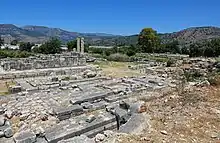Letoon
The Letoon (Ancient Greek: Λητῶον), sometimes Latinized as Letoum,[1] was a sanctuary of Leto near the ancient city Xanthos in Lycia. It was one of the most important religious centres in the region. The site is located south of the village Kumluova in the Fethiye district of Muğla Province, Turkey. It lies approximately four kilometres south of Xanthos along the Xanthos River.[2]
Λητῶον | |
 The foundations of the three temples at the Letoon are clearly visible. | |
 Shown within Turkey | |
| Alternative name | Letoum |
|---|---|
| Location | Kumluova, Muğla Province, Turkey |
| Region | Lycia |
| Coordinates | 36°19′55″N 29°17′23″E |
| Type | Sanctuary |
| Part of | Xanthos |
| History | |
| Founded | Late 6th century BCE |
| Abandoned | 7th century CE |
| Site notes | |
| Type | Cultural |
| Criteria | ii, iii |
| Designated | 1988 (12th session) |
| Reference no. | 484-003 |
| Part of | Xanthos-Letoon |
It was added as a UNESCO World Heritage Site along with Xanthos in 1988.
History
Archaeological finds at the site, which was never a fully-occupied settlement, but remained essentially a religious centre, date back to the late sixth century BCE. This was before the Greek cultural hegemony in Lycia, which began in the early fourth century. In earlier times, the site was probably already sacred to the cult of an earlier mother goddess — she is Eni Mahanahi in Lycia — which was superseded by the worship of Leto, joined by her twin offspring.[3]
In Greek mythology, a claim for an early cult of Apollo in the valley of the Xanthus, unsupported by history or archaeology, was provided by two myths, each connected to an eponymous "Lycus". One sprang from the autochthonous Telchines of Rhodes and would have colonized the region at the time of Deucalion's flood; the other Lycus was an Athenian brother of Aegeus driven from Athens, a seer who introduced the cult of Lycaean Apollo, which a folk etymology connected with Lycia and therefore made him its Athenian colonizer:[4] see Lycus (mythology).
The foundations of the Hellenistic temple dedicated to Leto, and her children, Artemis and Apollo, have been excavated under the direction of H. Metzger from 1962.[5] Archæologists have excavated much of the ruins; discoveries include the Letoon trilingual, bearing inscriptions in Greek, Lycian and Aramaic, which has provided crucial keys in the deciphering of the Lycian language; it is conserved in the Fethiye Museum.
The sacrosanctity of the site is the purport of an anecdote related by Appian concerning Mithridates, who was planning to cut down the trees in the sacred grove for his own purposes in his siege of the Lycian coastal city of Patara, but was warned against the sacrilegious action in a nightmare.[6] The site remained active through the Roman period. The site was Christianised by the construction of an early church, which reused cut stone from the sanctuary, but was abandoned from the seventh century CE.
Notes
- Note that the name has three syllables: Le-to-on or Le-to-um.
- Noted by Strabo, xiv.2.2 and 3.6.
- Lycian Turkey.
- Pierre Grimal, The Dictionary of Classical Mythology: "Lycus".
- H. Metzger, "Fouilles du Létôon de Xanthe (1962-65)" Revue archéologique (1966).
- Appian, Mithridates, 27, noted by T. R. Bryce, "The Arrival of the Goddess Leto in Lycia", Historia: Zeitschrift für Alte Geschichte, 321 (1983:1-13). p. 3 and note 9.
External links
| Wikimedia Commons has media related to Letoon. |
- The official website of the French Archaeological Mission of Xanthos-Letoon
- UNESCO World Heritage Centre: Xanthos-Letoon
- Canadian Epigraphic Mission at Xanthos-Letoon, website of the research project on Xanthos and Letoon by Université du Québec à Montréal and Université Laval, including downloadable published works
- Extensive picture collection of Letoon
- Letoon Photo Guide